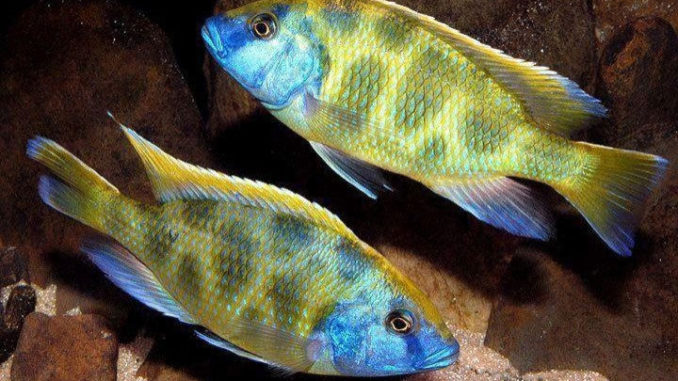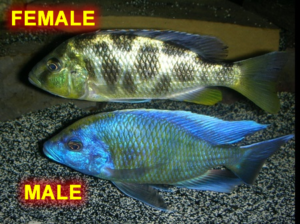
The Venustus or Giraffe cichlid is a very popular choice for Malawi lovers for their colours, patterns, larger size and temperament. They make a fantastic, striking addition to an African cichlid setup.
Common Name(s) : Venustus, Giraffe cichlid

Family : Cichlidae
Genus : Nimbochromis
Species : Nimbochromis venustus
Maximum Size : 25cm / 10 inches
Lifespan : 10-12 years
Aggression Level : Moderately Aggressive / Slightly Territorial (7/10)
PREFERRED WATER CONDITIONS
Tank Size : 120 Litres +
PH : 7.5 – 8.5
Hardness : Moderate to Hard
Temperature : 23 – 26°C / 73.4–78.8 °F
TANK SET UP
Nimbochromis venustus are endemic to Lake Malawi and Lake Malombe in eastern Africa. Adults inhabit generally sandy areas at depths depth between 49 – 65 feet (15 – 20 m) . Juveniles inhabit shallow waters near rocks and swim in schools. Replicate this in an aquarium by using a coral sand substrate and a few rocks for some cover.
SUITABLE TANK MATES
- Other African cichlids (of similar size)
- Clown Loaches, Featherfin Catfish, Cuckoo Catfish, Bristlenose Catfish, Plecos, Ghost Knives
- They can also sometimes live with barbs, American cichlids, Larger Gourami’s, Eels, Silver & Golden Perch, larger sharks, silver dollar and yabbies.
DIET
Venustus are omnivores, they will accept all foods including pellets, flake, frozen, green vegetable and algae. In the wild venustus feed almost exclusively on small fish and invertebrates. They use an ambush technique of partially burying themselves in the sand to catch unaware small fish prey as they swim near.
SEXING AND BREEDING
Sexing venustus is relatively easy in cichlid terms. Males certainly feature more colour – when 5cms, males feature a blue face with bright yellow markings across the head and dorsal fin. The female is less colourful with a duller yellow background behind a dark blotched pattern.
Venustus are maternal mouthbrooders. A sex mix of one male to 3 or so females is suggested and these should be kept alone and conditioned with frozen brine shrimp or bloodworm for a couple of weeks.
When ready to spawn, the male will become intense in colouration and will choose a spawning site, often on a flat rock surface or by digging a depression in the substrate.
Spawning occurs in a similar fashion to many other cichlids, with the female laying a line of eggs before moving away, allowing the male to take her place and fertilise them. She then returns to the site, picking up the fertilised eggs in her mouth before laying another batch.
She will carry the brood (usually 20 to 120 eggs) for around 3 weeks before releasing the free swimming fry. She will not eat during this period and can be easily spotted by her distended mouth and brooding colouration of dark patterning.
Female venustus are notorious for spitting out the brood early when stressed, so extreme care must be taken if you decide to move the fish.
The fry are large enough to accept frozen baby brine shrimp from the day they are released. Brood care by the female continues for another 10 days or so, with the fry seeking refuge in the mother’s mouth if they are disturbed.
